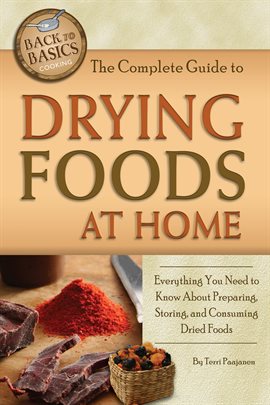Ramping up your food production skills may help ramp up your dietary options as well. Why not learn more about preparation, drying, canning and preservation? It puts you in charge of what’s in your food and provides more choices regarding the types of foods you can try. Best of all, you will no longer be limited to a relationship with the long-distance-shipped, salt/sugar/simple carb/fat-packed “food grid” of modern society. Time and other constraints may keep you largely on the grid, but you can explore your options by developing new skills, especially in food preservation.
Canning and Preservation
 The most intimidating traditional skill – for me, anyway – is canning. Succeeding is impressive, but screwing up leaves the possibility of mortally sickening yourself and your loved ones, something that hardly ever happens when knitting or quilting. Luckily, there’s lots of help to make sure you’re doing it right. Choose canning books written after the mid 1990′s, when new guidelines on pressure vs. boiling water canning were announced. Ground zero for the latest scientific information on food preservation is the National Center for Home Food Preservation at the University of Georgia, so this is a great place to start for worrywarts. If you want to hone in on canning, another great government resource, USDA Complete Guide to Home Canning (2015 revision), might be your choice. For a fun, creative take on things, try Homemade Living: Canning & Preserving by Ashley English. It gives a rundown on useful basic equipment and handy side tools, as well as a primer on different types of canned foods, like chutney, marmalade, and curds. Looking for a newer book on the subject? Check out The All New Ball Book of Canning and Preserving, which is organized by technique. It covers water bath and pressure canning, pickling, fermenting, freezing, dehydrating, and smoking. Straightforward instructions and step-by-step photos ensure success for beginners, while practiced home canners will find more advanced methods and inspiring ingredient twists. The most intimidating traditional skill – for me, anyway – is canning. Succeeding is impressive, but screwing up leaves the possibility of mortally sickening yourself and your loved ones, something that hardly ever happens when knitting or quilting. Luckily, there’s lots of help to make sure you’re doing it right. Choose canning books written after the mid 1990′s, when new guidelines on pressure vs. boiling water canning were announced. Ground zero for the latest scientific information on food preservation is the National Center for Home Food Preservation at the University of Georgia, so this is a great place to start for worrywarts. If you want to hone in on canning, another great government resource, USDA Complete Guide to Home Canning (2015 revision), might be your choice. For a fun, creative take on things, try Homemade Living: Canning & Preserving by Ashley English. It gives a rundown on useful basic equipment and handy side tools, as well as a primer on different types of canned foods, like chutney, marmalade, and curds. Looking for a newer book on the subject? Check out The All New Ball Book of Canning and Preserving, which is organized by technique. It covers water bath and pressure canning, pickling, fermenting, freezing, dehydrating, and smoking. Straightforward instructions and step-by-step photos ensure success for beginners, while practiced home canners will find more advanced methods and inspiring ingredient twists. |
More Books on Canning and Preserving
Food Fermentation
Food Drying
 I was intrigued by Food Drying with an Attitude. Drying is the oldest food preservation technique, and Mary T. Bell gets you back in touch with creating a lot of possibilities outside of dried fruit snacks: homemade jerkies with various meats, dried fruits that can be made into soups and jams, dried vegetables that can be powdered to create tasty flavoring ingredients for your cooked foods, camping foods, even pet snacks. Bell gives drying techniques and recipes, as well as recipes that use dried ingredients. It made me want to run out to buy a dehydrator. I was intrigued by Food Drying with an Attitude. Drying is the oldest food preservation technique, and Mary T. Bell gets you back in touch with creating a lot of possibilities outside of dried fruit snacks: homemade jerkies with various meats, dried fruits that can be made into soups and jams, dried vegetables that can be powdered to create tasty flavoring ingredients for your cooked foods, camping foods, even pet snacks. Bell gives drying techniques and recipes, as well as recipes that use dried ingredients. It made me want to run out to buy a dehydrator.
If you REALLY want to step off the grid, check out The Solar Food Dryer by Eben Fodor, part of a series of books by Mother Earth News. Solar drying (with a possible electrical backup) is a preservation technique that uses the least amount of manufactured energy. The book doesn’t go deep into drying techniques or recipes, but gives several detailed plans for building your own solar drier (even tips on how to make one from recycled materials), and explaining the principles of how they work in various climates. |
More Books on Food Drying
Food Storage
 Another concept in stepping off the grid is food storage–storing up food for a predetermined amount of time, like a few months or a year. In the Church of the Latter Day Saints (Mormons), it’s part of their belief in self-sufficiency. The problem is, as Crystal Godfrey notes in I Can’t Believe It’s Food Storage, putting up lots of dried milk, eggs, wheat and other long-term food that you don’t use in your everyday life leads you to dread the concept rather than embrace it. She points out that you already use these products daily if you use ready-made baking and cooking mixes, so why not make your own cheaper and to your own taste? You can take or leave the Mormon theology and still get lots of good takeaway ideas for running a household, like the “magic mix” that instantly creates white sauce for soups and side dishes and keeps for months in your fridge, or a way of creating a workable substitute for expensive sweetened condensed milk for baked goods. Godfrey includes lots of recipes and practical tips for easing into using dried foods. And while you may not have a church store to buy from, the Internet has made purchasing shelf stable food easier than it used to be, when the book was published. Another concept in stepping off the grid is food storage–storing up food for a predetermined amount of time, like a few months or a year. In the Church of the Latter Day Saints (Mormons), it’s part of their belief in self-sufficiency. The problem is, as Crystal Godfrey notes in I Can’t Believe It’s Food Storage, putting up lots of dried milk, eggs, wheat and other long-term food that you don’t use in your everyday life leads you to dread the concept rather than embrace it. She points out that you already use these products daily if you use ready-made baking and cooking mixes, so why not make your own cheaper and to your own taste? You can take or leave the Mormon theology and still get lots of good takeaway ideas for running a household, like the “magic mix” that instantly creates white sauce for soups and side dishes and keeps for months in your fridge, or a way of creating a workable substitute for expensive sweetened condensed milk for baked goods. Godfrey includes lots of recipes and practical tips for easing into using dried foods. And while you may not have a church store to buy from, the Internet has made purchasing shelf stable food easier than it used to be, when the book was published.
Closer to home, the Lucas County OSU Extension Service will answer your food preservation questions at 419-213-4254 (Mon-Fri, 9-4:30 PM), or the OSU Food Safety Hotline will do the same at 1-800-725-2751 (Mon-Fri, 9-5 PM). |
More Books on Food Storage
Looking for more books on food preservation?
Search our catalog using the following subject terms:
- Canning and Preserving
- Food — Preservation
- Food – Drying
- Dried Foods
- Fermentation
- Fermented Foods
- Food — Storage
- Fruit — Preservation
- Vegetables — Preservation
Featured Image Credit: Foodlander (flickr, Creative Commons license).



![Better homes and gardens complete canning guide [eBook - OverDrive] : Freezing, Preserving, Drying / Better Homes and Gardens Better homes and gardens complete canning guide [eBook - OverDrive] : Freezing, Preserving, Drying / Better Homes and Gardens](http://images.contentreserve.com/ImageType-100/0874-1/%7BF80E8739-D9FC-4E00-B13F-C0DCB20967F7%7DImg100.jpg)






